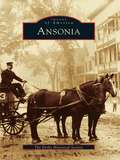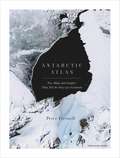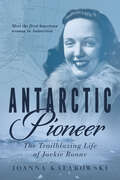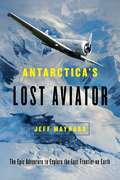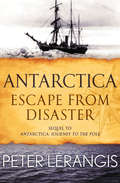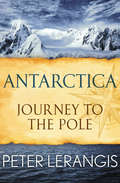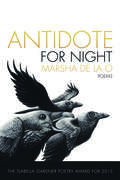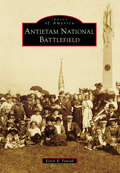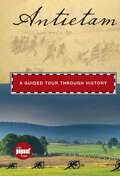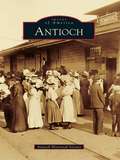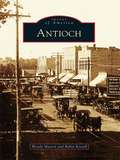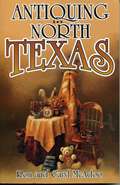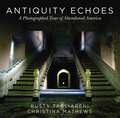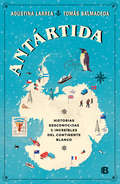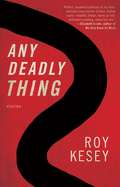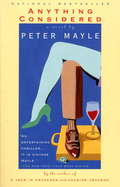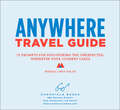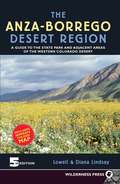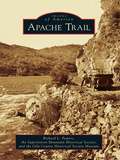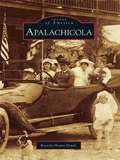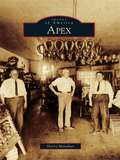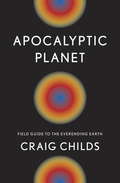- Table View
- List View
Ansonia (Images of America)
by The Derby Historical SocietyThe town of Ansonia is situated at the foot of Connecticut's Berkshire Hills, above the confluence of the Housatonic and Naugatuck Rivers. This manufacturing village was named for its founder, Anson Phelps, a businessman who played a prominent role in the community. Ansonia shares its earliesthistory with the neighboring town of Derby, of which it was a part until 1889. Ansonia has been called the Industrial Heart of the Naugatuck Valley. Yet, as you will see inside, its history is rich beyond its industry. Ansonia highlights the town's wonderfulold homes and churches. This one town had 25 churches at one time. The book follows the town through good times as well as hard times, such as the Blizzard of 1888 and the Flood of 1955 and the redevelopment days that followed.
Antarctic Atlas: New Maps and Graphics That Tell the Story of A Continent
by Peter FretwellA FINANCIAL TIMES BOOK OF THE YEAR 2020SHORTLISTED FOR THE ESTWA AWARD FOR ILLUSTRATED TRAVEL BOOK OF THE YEAR 2022One of the least-known places on the planet, the only continent on earth with no indigenous population, Antarctica is a world apart. From a leading cartographer with the British Antarctic Survey, this new collection of maps and data reveals Antarctica as we have never seen it before.This is not just a book of traditional maps. It measures everything from the thickness of ice beneath our feet to the direction of ice flows. It maps volcanic lakes, mountain ranges the size of the Alps and gorges longer than the Grand Canyon, all hidden beneath the ice. It shows us how air bubbles trapped in ice tell us what the earth's atmosphere was like 750,000 years ago, proving the effects of greenhouse gases. Colonies of emperor penguins abound around the coastline, and the journeys of individual seals around the continent and down to the sea bed in search of food have been intricately tracked and mapped. Twenty-nine nations have research stations in Antarctica and their unique architecture is laid out here, along with the challenges of surviving in Antarctica'sunforgiving environment.Antarctica is also the frontier of our fight against climate change. If its ice melts, it will swamp almost every coastal city in the world. Antarctic Atlas illustrates the harsh beauty and magic of this mysterious continent, and shows how, far from being abstract, it has direct relevance to us all.
Antarctic Pioneer: The Trailblazing Life of Jackie Ronne
by Joanna KafarowskiJackie Ronne reclaims her rightful place in polar history as the first American woman in Antarctica. Jackie was an ordinary American woman whose life changed after a blind date with rugged Antarctic explorer Finn Ronne. After marrying, they began planning the 1946–1948 Ronne Antarctic Research Expedition. Her participation was not welcomed by the expedition team of red-blooded males eager to prove themselves in the frozen, hostile environment of Antarctica.On March 12, 1947, Jackie Ronne became the first American woman in Antarctica and, months later, one of the first women to overwinter there.The Ronne Antarctic Research Expedition secured its place in Antarctic history, but its scientific contributions have been overshadowed by conflicts and the dangerous accidents that occurred. Jackie dedicated her life to Antarctica: she promoted the achievements of the expedition and was a pioneer in polar tourism and an early supporter of the Antarctic Treaty. In doing so, she helped shape the narrative of twentieth-century Antarctic exploration.
Antarctica's Lost Aviator: The Epic Adventure To Explore The Last Frontier On Earth
by Jeff MaynardThe astonishing voyage of the first solo crossing of Antarctica by the unlikeliest of arctic explorers. By the 1930s, no one had yet crossed Antarctica, and its vast interior remained a mystery frozen in time. Hoping to write his name in the history books, wealthy American Lincoln Ellsworth announced he would fly across the unexplored continent. And to honor his hero, Wyatt Earp, he would carry his gun belt on the flight. The main obstacles to Ellsworth’s ambition were numerous: he didn’t like the cold, he avoided physical work, and he couldn’t navigate. Consequently, he hired the experienced Australian explorer, Sir Hubert Wilkins, to organize the expedition on his behalf. While Ellsworth battled depression and struggled to conceal his homosexuality, Wilkins purchased a ship, hired a crew, and ordered a revolutionary new airplane constructed. The Ellsworth Trans-Antarctic Expeditions became epics of misadventure, as competitors plotted to beat Ellsworth, pilots refused to fly, crews mutinied, and the ship was repeatedly trapped in the ice. Finally, in 1935, Ellsworth took off to fly from the Weddell Sea to the Ross Sea. A few hours after leaving, radio contact with him was lost and the world gave him up for dead. Antarctica’s Lost Aviator brings alive one of the strangest episodes in polar history, using previously unpublished diaries, correspondence, photographs, and film to reveal the amazing true story of the first crossing of Antarctica and how, against all odds, it was achieved by the unlikeliest of heroes.
Antarctica: Escape from Disaster (Antarctica Ser. #Vol. 2)
by Peter LerangisTrapped in Antarctic ice, Jack Winslow and his sons fight to get homeIt has been nearly a year since Jack Winslow and his two sons, Colin and Andrew, set out to conquer Antarctica. While Colin and most of the crew stayed behind on the ship, Andrew made a dash for the South Pole, nearly dying in the process. When he returns to the Mystery, frostbitten and frail, the ship has become wedged between two ice floes. As the crew hacks at the ice with pick-axes, trying desperately to free the ship, the ice shifts, shattering the hull and giving the Winslows and their team just enough time to gather provisions before the Mystery plummets into the frigid water. Hundreds of miles of ice and sea stand between the Winslows and safety. As food becomes scarce, the crew begins grumbling of mutiny. Colin and Andrew are tired, hungry, and freezing cold—but their struggle for survival has only just begun. This ebook features an illustrated biography of Peter Lerangis including rare photos and never-before-seen documents from the author&’s personal collection.
Antarctica: Journey to the Pole
by Peter LerangisA father and his sons embark on a perilous trek to the ends of the earthIt is May 1909, and the race to the South Pole is on. For years, Jack Winslow has dreamed of conquering the frozen wasteland, but just before he sets sail, his wife dies suddenly. Rather than cancel the voyage, he brings his two grief-stricken sons, Colin and Andrew, on the adventure of a lifetime. Although the teenagers have read widely of the Antarctic and the icy, unforgiving sea that surrounds it, no book could prepare them for the journey ahead. Killer whales, temperatures as low as –100°F, and deadly crushing ice floes are only the beginning of their troubles. To survive this trip, the Winslows will have to set aside their grief and come together as a family. This ebook features an illustrated biography of Peter Lerangis including rare photos and never-before-seen documents from the author&’s personal collection.
Antidote for Night
by Marsha de la OSet in present-day Southern California, Antidote for Night is a heartbreak lyric, a corrido, a love song to California's city lights and far-flung outskirts—the San Diego backcountry, the Central Valley, the Inland Empire, and the Mojave Desert. Marsha de la O's voice is a kind of free jazz, musically rich with LA noir and the vastness of metropolitan Southern California.Marsha de la O's Black Hope won the New Issues Prize from the University of Western Michigan and an Editor's Choice Award. She has taught Spanish-speaking children in Los Angeles and Ventura County for thirty years.
Antietam National Battlefield (Images of America)
by Kevin R. PawlakApproximately 110,000 soldiers of the Union and Confederate armies fought along the banks of Antietam Creek in the bloodiest single-day battle in American history. In 12 hours of fighting, approximately 23,000 men fell, either killed, wounded, or missing, forever scarring the landscape around the town of Sharpsburg. Established as the Antietam Battlefield Site in 1890, Antietam National Battlefield became a National Park Service landmark in 1933. The park grew from 33 acres in the 1890s to encompassing over 3,000 acres today. Some of the Civil War's most recognizable landmarks now sit within its boundaries, including Dunker Church, Bloody Lane, and Burnside Bridge. The events that occurred across the fields and woodlots around Sharpsburg and along Antietam Creek bring hundreds of thousands of visitors to Antietam National Battlefield every year.
Antietam: A Guided Tour Through History (Timeline)
by Cynthia ParzychWalk through the battlefield of Antietam with those who fought thereThe Battle of Antietam, waged on September 17, 1862, marked the bloodiest single day&’s fighting in American history. Five days later, President Abraham Lincoln issued the preliminary Emancipation Proclamation. This book brings you face-to-face as never before with the people and events that shaped this epic event. It features:- An introduction discussing the history and preservation of the present-day site- A timeline that adds further texture to the history described- Concise biographies of key participants- A historical tour- Where to stay and eat, and places to visit nearby - Archival and color photos throughout- Two PopOut maps—an archival map showing the battle as it unraveled, and another showing the same location today About the Timeline seriesThese one-of-a-kind books bring you face to face with the people and events that have shaped American history and who have left their mark on some of the nation&’s most important historical landmarks and locations.
Antioch
by Antioch Historical SocietyWhen the first settlers arrived here in 1850, they could never have guessed that their tiny settlement would one day be home to over 100,000 souls, scores of factories, and the gateway to the California Delta with some of the most productive agricultural lands in the world. In earlier days, the Sacramento and San Joaquin Rivers were the main routes into the state's interior, as the swampy delta land had yet to be tamed. Antioch and nearby Pittsburg served as major depots for supplies to the Sierra gold fields, stockpiling lumber, produce, hay, dry goods, medicine, and fuel from the Stewartville, Empire, and Judsonville coal mines. Named in 1851 after the biblical city in Syria, this town served for many years as the Bay Area's easternmost outpost and provided its inhabitants with a bounty both man-made and natural.
Antioch
by Wendy Maston Robin KessellAntioch is a unique small town at the border between Illinois and Wisconsin. Its rich history and strong family values have supported the village since the first families arrived in the early 1800s. In 1983, a group of dedicated people decided the history of Antioch was slipping away and started the Lakes Region Historical Society. Since that time the community has responded with thousands of artifacts and pictures of early Antioch. From the humble beginnings in log cabins along the shores of Loon Lake to the active community of today, the pictures lead one back in time. Antioch blossomed during the 1890s and early 1900s when the Chicago area discovered the beauty of the lakes in the region.Resorts opened everywhere, almost overnight it seemed, and crowds flooded the area. Most came on the train; others came in the new horseless carriages. The village of Antioch expands way beyond its legal limits. The surrounding area depends on the village for much of its needs. The lakes still thrive today because of the workings of the little town. Although the population is only in the thousands, the unincorporated area swells that number to double its size.
Antiquing in North Texas: A Guide to Antique Shops, Malls, and Flea Markets
by Caryl McAdoo Ron McAdooWhether you're seaching for something special to add to your home decor, a treasured item from your childhood, or just out for the fun of it, antiquing can be a relaxing and rewarding experience.
Antiquity Echoes: A Photography Tour of Abandoned America
by Rutsy Tagliareni Christina MathewsAntiquity Echoes is a guided tour of some of our nation's most compelling abandoned locations. With a wide spectrum of places covered, readers will be walking the dark halls of an abandoned mental asylum on one page and lost in the overgrowth of an abandoned theme park on the very next. With a focus on history and first-hand accounts by the author, Antiquity Echoes is far more than a collection of photography and text, it's an adventure story. Photographer Rusty Tagliareni spent years traveling the country documenting forlorn locations throughout the United States, sharing his deep passion for history and preservation and what has generated alliances with many historic societies and preservation organizations. What makes a place worth remembering? Antiquity Echoes ventures that this value derives from the lessons a place can teach us, even long after it has been of use. No matter how forgotten a place has come to be, underneath the overgrowth, cracked paint, and filth of ages, lie countless stories awaiting a sympathetic ear.
Antártida: Historias desconocidas e increíbles del continente blanco
by Tomás Balmaceda Agustina LarreaLa Antártida es el lugar más extraño del planeta, la única parte de la Tierra donde los humanos nunca podrían sobrevivir sin ayuda. Este libro presenta un compendio de historias de distintas épocas, proezas de su pasado e interrogantes sobre su futuro. Dos grupos de aventureros se enfrentan en un desafío que les costará la vida: navegar miles de kilómetros para llegar a tierras desconocidas antes que los rivales. Una expedición militar argentina lanza a un perro en paracaídas desde un avión para rescatar a exploradores perdidos en la inmensidad. Una mujer aislada por un crudo temporal decide operarse a sí misma de un tumor. Una supuesta misión científica planta una bandera gigante en la nieve al grito de "¡Heil Hitler!". La enorme extensión de la Antártida parece envolverlo todo: misterios sin resolver, amores, peleas, muertes e historias de superación personal. Tras una exhaustiva investigación, este libro rescata las grandes epopeyas y también las pequeñas historias de quienes se animaron a habitar un territorio tan misterioso como encantador. El resultado es una guía atrapante que recorre el pasado, el presente y el futuro del continente antártico e intenta responder una pregunta: ¿qué secreto envuelve este lugar al que muchos quisieron y siguen queriendo ir sin saber demasiado sobre él?
Any Deadly Thing
by Roy KeseyFollowing the critical success of his debut collection, All Over, and of his debut novel, Pacazo, Roy Kesey now brings us a new gathering of short stories, Any Deadly Thing. These stories first appeared in magazines including McSweeney's, Subtropics, Ninth Letter and American Short Fiction, and have been widely anthologized; among them are winners of a Pushcart Prize special mention, an Honorable Mention in The Year's Best Fantasy and Horror, and The Missouri Review's Jeffrey E. Smith Editors' Prize in Fiction. With story locales ranging across the Americas to Europe and Asia, Kesey once again makes the full strange world his stage. "Perfect, masterful portraits of an international cross-section of wise, broken souls--hopeful, brutal, funny as hell, and heart-crushing, every last one." -Elizabeth Crane, author of We Only Know So Much "Roy Kesey is one of my favorite contemporary writers, and Any Deadly Thing is another triumph. These stories, reminiscent of William Gass in the remarkable way they combine a virtuoso playfulness and wit with an atmosphere of grimness and grief and heartbreak, range the world over for their brilliantly realized locales, but they share a deeper setting in what Gass calls 'the only holiness we have,' human consciousness. Kesey demonstrates once again that he is a spectacularly deft and empathetic priest of that creed, which is the only one for me." -Michael Griffith, author of Trophy
Anyone but Him: A touching story about love, heartache and family ties
by Sheila O'FlanaganSheila O'Flanagan's bestseller ANYONE BUT HIM is a touching and page-turning read about love, heartache and the unbreakable bond between sisters, not to be missed by readers of Kerry Lonsdale and Jamie Beck. 'A must-read' Woman's OwnAndie and her sister Jin have never seen eye to eye. Andie doesn't envy Jin her marriage to a wealthy businessman, while Jin can't believe Andie's happy with her man-free existence (if only she knew!). But when their widowed mother Cora comes back from a Caribbean cruise with more than just a suntan, Andie and Jin are united in horror. Who is this gorgeous young man who's swept their mother off her feet? What the women really need is a friend to set the world to rights with - but can they be friends with each other?(P)2004 WF Howes Ltd
Anyone but Him: A touching story about love, heartache and family ties
by Sheila O'FlanaganSheila O'Flanagan's bestseller ANYONE BUT HIM is a touching and page-turning read about love, heartache and the unbreakable bond between sisters, not to be missed by readers of Freya North and Jojo Moyes. 'A must-read' Woman's OwnAndie and her sister Jin have never seen eye to eye. Andie doesn't envy Jin her marriage to a wealthy businessman, while Jin can't believe Andie's happy with her man-free existence (if only she knew!). But when their widowed mother Cora comes back from a Caribbean cruise with more than just a suntan, Andie and Jin are united in horror. Who is this gorgeous young man who's swept their mother off her feet? What the women really need is a friend to set the world to rights with - but can they be friends with each other?What readers are saying about Anyone But Him: 'Beautifully written - a delight getting to know the characters' Amazon reviewer, 5 stars'One of Sheila O'Flanagan's best novels. It hooked me from the beginning, and had several twists along the way' Amazon reviewer, 5 stars'The story is very easy to get into and moves at just the right pace. The characters are fantastic, in particular the two sisters - I can imagine a lot of readers relating to their relationship' Amazon reviewer, 5 stars
Anyone but Him: A touching story about love, heartache and family ties
by Sheila O'FlanaganSheila O'Flanagan's bestseller ANYONE BUT HIM is a touching and page-turning read about love, heartache and the unbreakable bond between sisters, not to be missed by readers of Freya North and Jojo Moyes. 'A must-read' Woman's OwnAndie and her sister Jin have never seen eye to eye. Andie doesn't envy Jin her marriage to a wealthy businessman, while Jin can't believe Andie's happy with her man-free existence (if only she knew!). But when their widowed mother Cora comes back from a Caribbean cruise with more than just a suntan, Andie and Jin are united in horror. Who is this gorgeous young man who's swept their mother off her feet? What the women really need is a friend to set the world to rights with - but can they be friends with each other?What readers are saying about Anyone But Him:'Beautifully written - a delight getting to know the characters' Amazon reviewer, 5 stars'One of Sheila O'Flanagan's best novels. It hooked me from the beginning, and had several twists along the way' Amazon reviewer, 5 stars'The story is very easy to get into and moves at just the right pace. The characters are fantastic, in particular the two sisters - I can imagine a lot of readers relating to their relationship' Amazon reviewer, 5 stars
Anything Considered: A Novel ([omega Literaria] Ser.)
by Peter MayleBennett is an English expatriate living in France with a champagne taste and a beer bankroll. Happy-go-lucky and a bit roguish, he places an ad in the International Herald Tribune offering his services -- any services. He pursues a response from a wealthy Englishman named Julian Poe who has developed a means of producing truffles and is close to cornering the immensely lucrative truffle market. Bennett signs on and finds himself in Monaco, where he is able to live in a style to which he has always wished to become accustomed (including eating to his heart's content -- a Mayle trademark!). Soon the Sicilian and Corsican Mafiosi intrude and Bennett is joined by the beautiful and experienced (in all ways) Anna. Ham-fisted goons, gendarmes working at cross purposes, French village busybodies, and an order of monks dedicated to the god Bacchus all play a role in the surprising, and more than a little satisfying, denouement.
Anywhere Travel Guide: 75 Prompts for Discovering the Unexpected, Wherever Your Journey Leads
by Magda Lipka FalckSeventy-five ways to embrace a spirit of adventure—around the world or around the corner.Ask the next person you meet where his/her favorite street is. Go there.Write down what you like about this city on a small piece of paper. Leave it where someone else will find it later.If you can see a shop from where you are, step inside it.A creative travel guide for anywhere, this handy book includes seventy-five inspirations for exploration. With a unique mix of concrete actions and whimsical prompts, the Anywhere Travel Guide takes you on a journey that encourages you to see things differently, to discover both new and familiar places—and to bring a new spirit of adventure to your life.
Anza-Borrego Desert Region
by Lowell Lindsay Diana LindsayNow in its expanded 5th edition, The Anza-Borrego Desert Region offers complete coverage of the over 1 million acres of desert lands, including Anza-Borrego State Park, Ocotillo Wells State Vehicular Recreation Area (OWSVRA), parts of the Santa Rosa and San Jacinto Mountains National Monument, and adjacent BLM recreational and wilderness lands.
Apache Trail
by Gila County Historical Museum Richard L. Powers Superstition Mountain Historical SocietyPres. Theodore Roosevelt once referred to the Apache Trail as "one of the most spectacular best-worth-seeing sights of the world." The once narrow, ancient foot trail built as a supply road for the construction of Roosevelt Dam has now evolved into a state highway with majestic scenic vistas and historical grandeur. Even in the 1920s, the Southern Pacific Railroad touted this road as a "must-see side trip." Each year, thousands of people venture along the trail to take a step back in time and relish the breathtaking experience of this fabulous journey. The Fish Creek Hill section remains much as it was back in the early 1900s, a narrow one-vehicle passage on an extremely steep incline that drops 900 feet within a mile along the edge of a steep cliff. Although several miles of the road are now paved, dirt portions remain that allow tourists a sense of perilous adventure.
Apalachicola (Images of America)
by Beverly Mount-DoudsOnce the third-largest port on the Gulf of Mexico, Apalachicola's diverse and colorful past remains visible today. With more than 900 historic homes and buildings in the National Register Historic District, visitors are invited to stroll along the picturesque, tree-lined streets where Victorian homes display the charm of years gone by. This delightful little fishing village has a warm and friendly atmosphere, making it even more appropriate that Apalachicola's name is a Native American word meaning "friendly people." When Apalachicola was established in 1831, its major industry was the shipping of cotton, and the city soon became an important port on the Gulf of Mexico. When the railroads expanded throughout the United States, Franklin County developed several large lumber mills to harvest and process wood from the surrounding cypress forests. These lumber magnates built many of the magnificent historic homes that still line Apalachicola's streets today.
Apex
by Sherry MonahanThis quaint, picturesque community has an interesting history. For years it was a rural hamlet with a nearby pond, simply called Log Pond. It later became Apex, and the pond was eventually drained in the name of progress. Apex appeared on the map because of the coalfields in Chatham/Lee County. The coal companies needed to get their coal to Raleigh, and around 1870, the Chatham Railroad was chugging along, right by Log Pond. It officially became Apex with the establishment of a post office. Apex put the railroad to use immediately and shipped lumber, tar, turpentine, and pitch. Early on, Apex passed a few ordinances that some might find in the Wild West, including those dealing with whiskey, gambling, and prostitution. The town suffered two fires in the early 1900s, but its residents persevered, and Apex's small-town charm is still enjoyed today.
Apocalyptic Planet
by Craig ChildsThe earth has died many times, and it always comes back looking different. In an exhilarating, surprising exploration of our planet, Craig Childs takes readers on a firsthand journey through apocalypse, touching the truth behind the speculation. Apocalyptic Planet is a combination of science and adventure that reveals the ways in which our world is constantly moving toward its end and how we can change our place within the cycles and episodes that rule it. In this riveting narrative, Childs makes clear that ours is not a stable planet, that it is prone to sudden, violent natural disasters and extremes of climate. Alternate futures, many not so pretty, are constantly waiting in the wings. Childs refutes the idea of an apocalyptic end to the earth and finds clues to its more inevitable end in some of the most physically challenging places on the globe. He travels from the deserts of Chile, the driest in the world, to the genetic wasteland of central Iowa to the site of the drowned land bridge of the Bering Sea, uncovering the micro-cataclysms that predict the macro: forthcoming ice ages, super-volcanoes, and the conclusion of planetary life cycles. Childs delivers a sensual feast in his descriptions of the natural world and a bounty of unequivocal science that provides us with an unprecedented understanding of our future.
